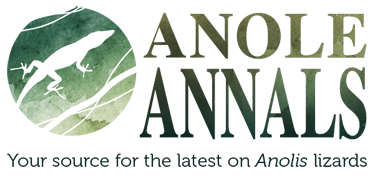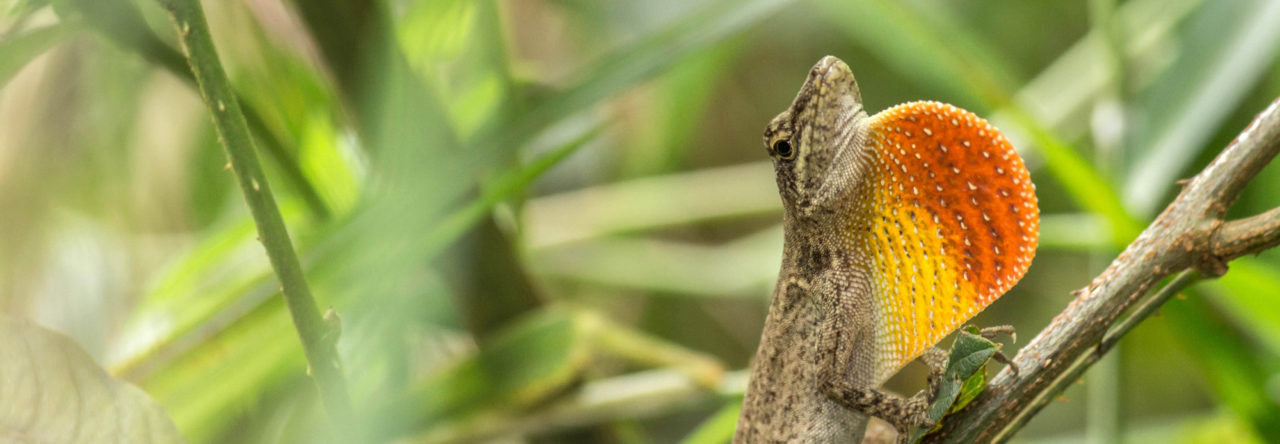Urbanization poses a major challenge for many species, altering natural environments in ways that few animals can tolerate. Despite this, some species persist and even thrive in urban areas. In my research in the Revell lab at UMass Boston, I’ve been studying adaptation in response to urbanization in Anolis cristatellus, the Puerto Rican crested anole. However, among anoles urban tolerance is by no means restricted to A. cristatellus. We suspect that readers of this blog have probably observed many different anole species occupying and thriving in urban areas. Consequently, we would like to ask for your help in gathering some information on this topic.
This is a video from the YouTube channel of the thetravelholics that I stumbled upon a while ago showing two male A. allisoni fighting.
Notice:
1.The male that had the upper hand turned brown while the losing male remained blue throughout the fight.
2.When the male turned brown some of the skin on the back of his neck remained blue, this is possibly an example of selective color change.
3.Both males had prominent shoulder patches and black patches behind the eyes.
 We found the lizard depicted above in the herpetological collection at the University of Kansas. We have no information about where it is from or who collected it. Can anybody help us identify what species it is?
We found the lizard depicted above in the herpetological collection at the University of Kansas. We have no information about where it is from or who collected it. Can anybody help us identify what species it is?
Now that’s a dewlap! Photo by Niranjan Sant
All of us that observe and study Anolis (and Sitana) know that dewlaps make our favourite lizards special. Dewlaps can be key for species identification, and we pay a lot of attention to variation in their size and colour. But what exactly constitutes a dewlap?
I’m currently compiling a list of all lizard species with dewlaps, and have run into the problem of how to define a dewlap. Our trusted friend Wikipedia defines a dewlap thus: a longitudinal flap of skin that hangs beneath the lower jaw or neck of many vertebrates. Helpful, perhaps, but only slightly, as the difference between a small dewlap and a puffed-out throat is not always obvious.
So we’re turning to you, dear reader, to help us figure out what a dewlap is. I think the easiest way to do so is by showing you a number of pictures of lizards and asking you to deliver a verdict on whether these lizards are in fact dewlapped (photos from various internet sources). Feel free to offer an alternative definition also, if you’d like.
1. Rock Agama
2. Calotes calotes from Sri Lanka
3. Panther chameleon
4. Varanus griseus
5. Iguana iguana
Working with the brown anole (Anolis sagrei) is an eye-opener to the ability of some species to disperse far beyond the barriers that limit their natural dispersal potential. Anolis sagrei from Florida managed to reach Taiwan, most likely along with some nursery or agricultural products. They have also managed to reach Singapore, also I suspect along with some nursery products.
Recently, an instance of a non-anole long-distance traveler came to my attention, and I would like to ask if anyone can help us identify the species involved. A friend told me about a snake that he obtained from someone, who got it from a person who imported wood from South America. Apparently, as the importer was about to start processing the wood he received, the snake slithered out of it. To me, the snake looks like a neotropical whipsnake (Masticophis mentovarius). However, it traveled by ship, meaning it could have gotten onboard at any port where the ship might have stopped. Thanks.
Doesn’t get much more festive than this guy!
I’m currently preparing a grant proposal featuring Anolis sagrei for a philanthropic foundation with broad goals that extend well beyond biology. The people reading this proposal will thus have diverse backgrounds, probably mostly non-biological and certainly non-herpetological. In reading a draft of the proposal, a friend remarked “This lizard needs a new name for this grant!” And, indeed, on reflection perhaps “brown anole” is not the most exciting name for the general public.
So, who wants to help re-brand A. sagrei? Of course, an obvious possibility is Sagra’s Anole, since the species was, after all, named after Mssr. Ramon de la Sagra*. But…that’s not really that exciting either. My friend (a biologist) suggested “the tramp anole,” using “tramp” in the ecological sense of a weedy species that is able to colonize and establish in a wide variety of habitats. A possibility, for sure, but maybe some of the other connotations aren’t so good. His second suggestion, though, merit’s consideration. Turns out that “sagre” in Italian means “a festival.” And what lizard could be more of a partier than the ever-flashing, always rollicking, A. sagrei? So, I put it to you, anole world, what if we start referring to this species as “the festive anole”?
*It’s an interesting story how the species ended up A. sagrei, and not A. sagrai, but that’s a tale for another time.

 There’s been discussion about blue anoles previously on Anole Annals, but I’ve come across yet another on the internet. The anole in the above picture is a species from the Sierra de Bahoruco in the Dominican republic. Apparently it has not been formally described yet and so does not yet have a name, but from the looks of it I would say it was related to A.alliniger or singularis. This actually leaves Puerto Rico as the only island without a blue trunk-crown anole. I have found one other picture of this species on Flickr (though it does not allow for posting on other web pages).
There’s been discussion about blue anoles previously on Anole Annals, but I’ve come across yet another on the internet. The anole in the above picture is a species from the Sierra de Bahoruco in the Dominican republic. Apparently it has not been formally described yet and so does not yet have a name, but from the looks of it I would say it was related to A.alliniger or singularis. This actually leaves Puerto Rico as the only island without a blue trunk-crown anole. I have found one other picture of this species on Flickr (though it does not allow for posting on other web pages).
Below is another photo from the Anolis Contact Group, of yet another new species that appears to be related to singularis.

Various anole species have been observed feeding on fruit (e.g., Herrel et al. 2004) and nectar (e.g., Colón Archilla 2010). On March 08, 2013 a brown anole (Anolis sagrei) male in my study area joined the growing list of lizards that have been observed feeding on plant sap. In our natural history note we not only describe how he fed on the sap of a banana plant (Musa sapientum), but also provided some notes on its display behavior.
Natural history notes like this usually describe single observations and may seem of minor significance. However, such observations contribute to our understanding of the natural history of the species in question, and can be an inspiration for study areas. And for that reason I encourage everyone to describe observations not only in Internet blogs, but also in journals such as Herpetology Notes and Herpetological Review. That way the information can be shared with a greater readership, and a record is left for generations to come.
NOTE: For those of you who are curious. I also wanted to know what the sap tasted like, so after touching some of it, I licked the tip of my finger. The sap had a very mild bitter taste, not something I would try to market as a soft drink.
 Daylight Savings End Special! Less than $25! If you’re going to buy an anole watch (check out the five different ecomorphs), now’s the time. Go to www.zazzle.com, use code watchclocks3
Daylight Savings End Special! Less than $25! If you’re going to buy an anole watch (check out the five different ecomorphs), now’s the time. Go to www.zazzle.com, use code watchclocks3









